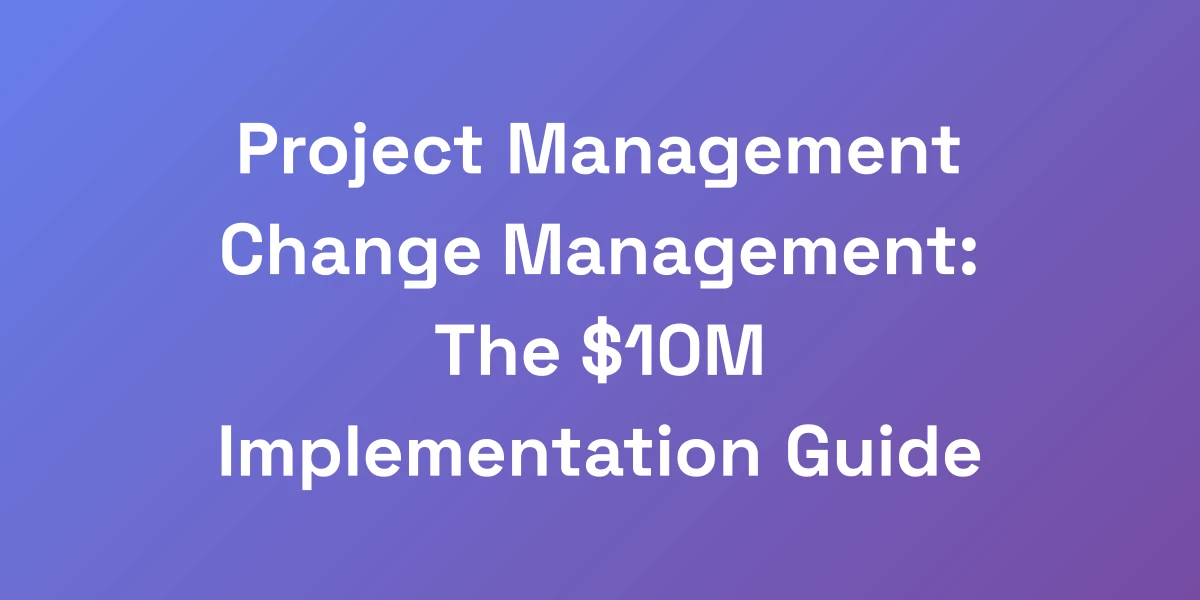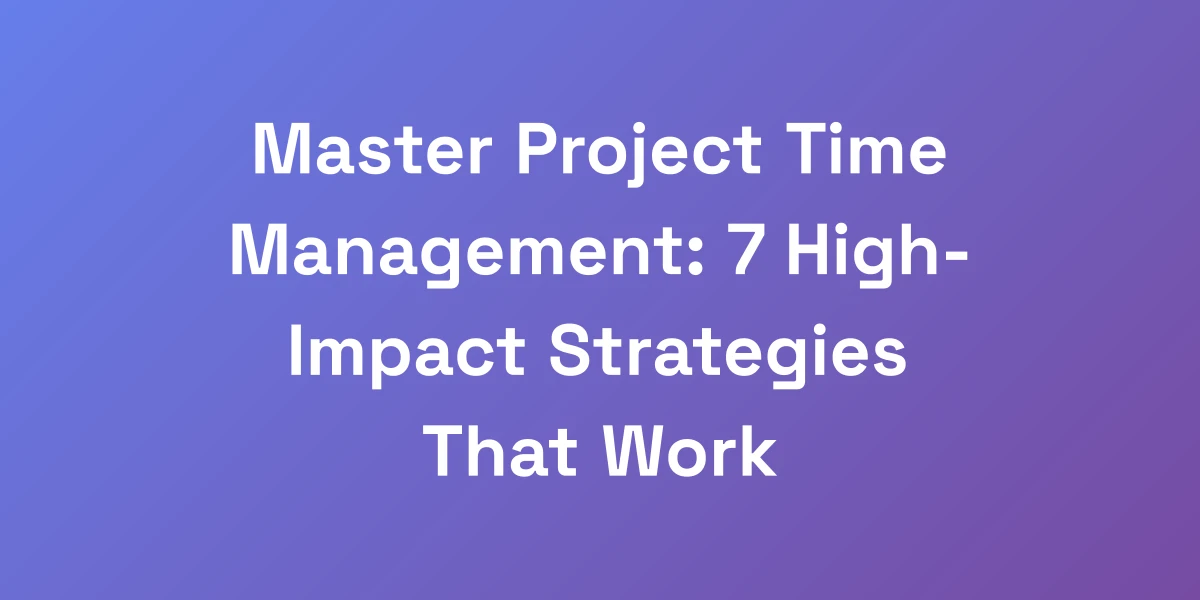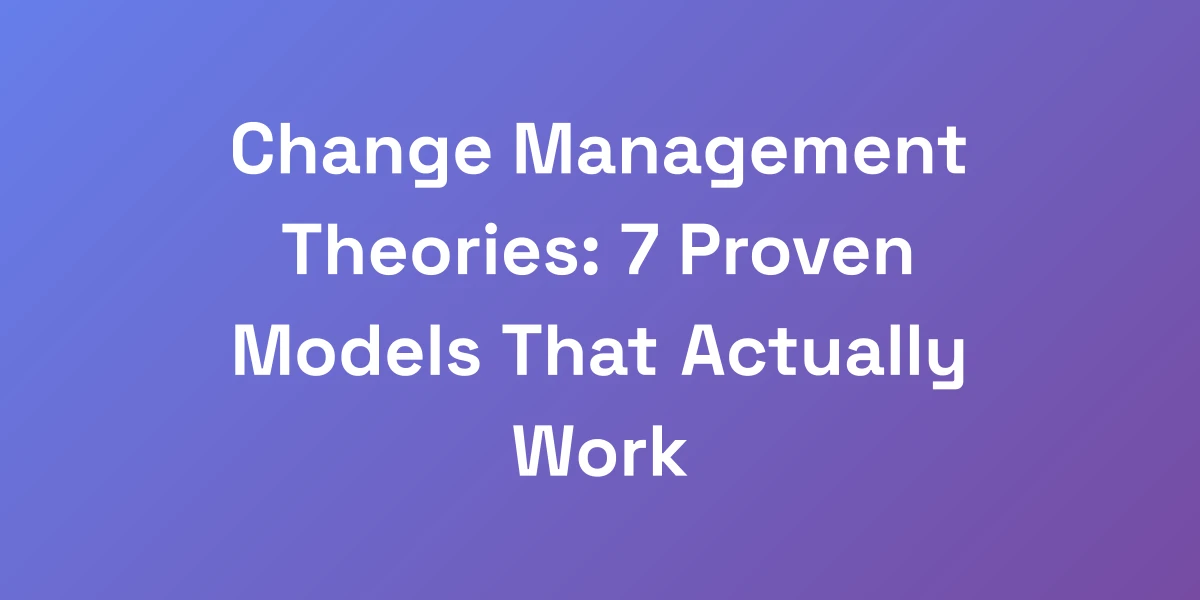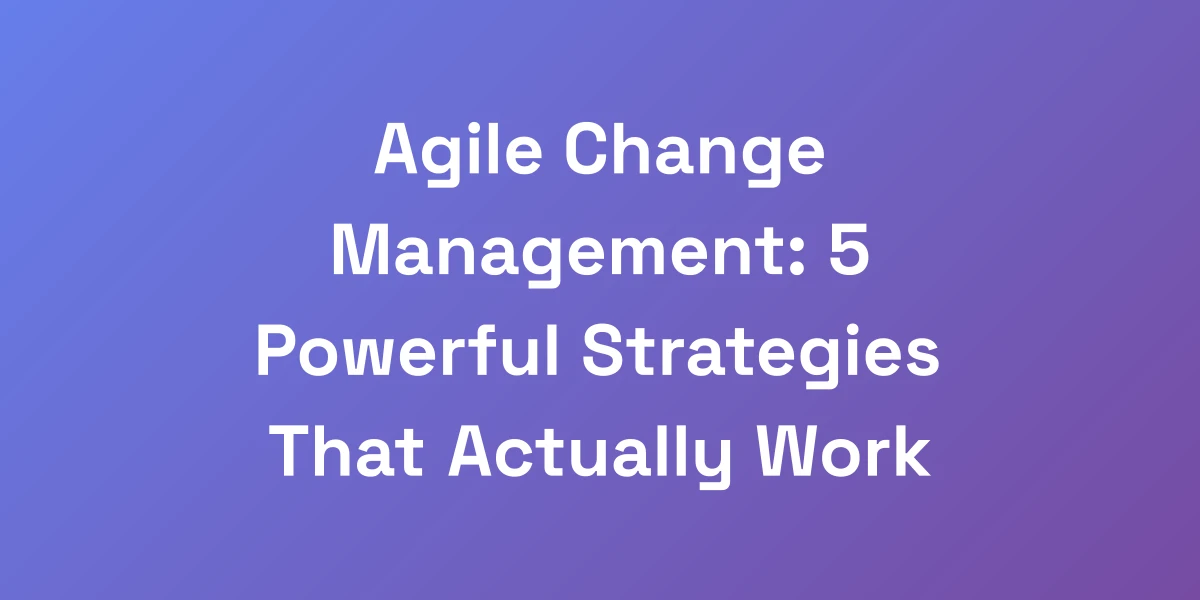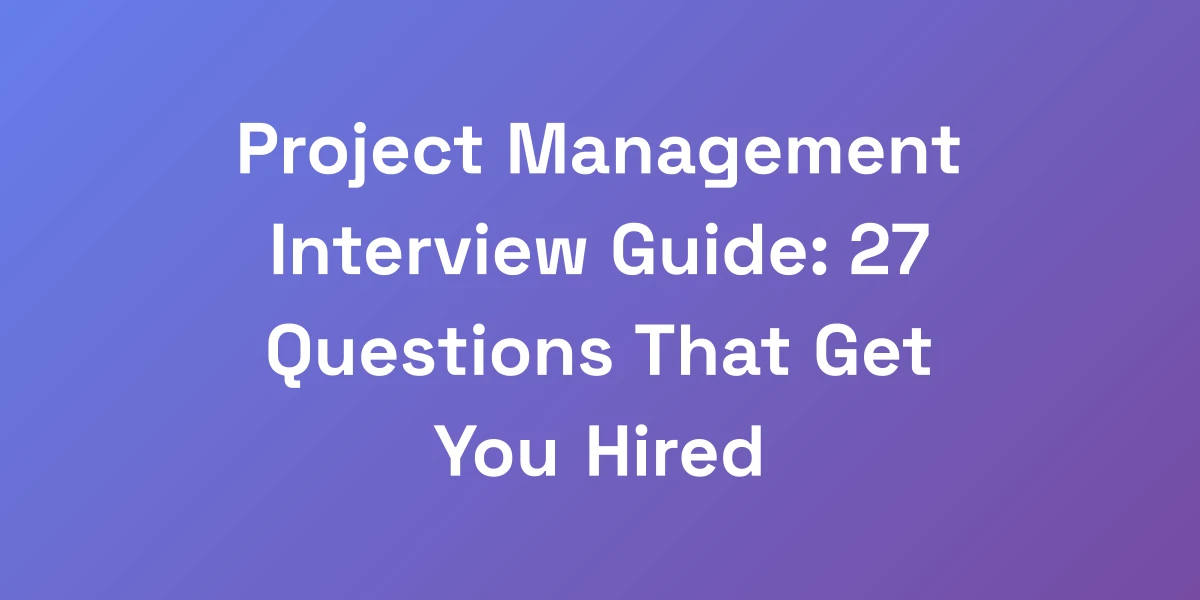
Project Management Interview Guide: 27 Questions That Get You Hired
Mar 17, 2025 | By [email protected]
Let’s cut through the BS – project management interviews aren’t just about answering questions, they’re about proving you can lead million-dollar initiatives and handle chaos like a pro. We’ve sat on both sides of the table, and we’re going to show you exactly how to transform your interview answers from amateur hour to executive level. What you’re about to read isn’t the same recycled garbage you’ll find elsewhere – these are battle-tested strategies that have helped our mentees land six-figure project management roles.
Project management interviews can feel like high-stakes games. The pressure is real, and the competition is fierce. But here’s the thing – the right approach can make all the difference. We’re diving deep into the nitty-gritty of what interviewers are truly looking for and how you can showcase your skills to stand out. Ready to dominate your next project management interview? Let’s get into it.
The Psychology Behind Project Management Interview Questions
Here’s the raw truth about project management interviews that nobody tells you: 90% of candidates answer questions like robots, regurgitating what they think the interviewer wants to hear. But here’s the game-changing insight – interviewers are actually screening for three core qualities: your ability to make decisions under pressure, lead without authority, and turn chaos into results. Every question they ask is designed to reveal these qualities, whether you realize it or not.
Understanding the Interviewer’s Hidden Agenda
Ever wondered why certain questions pop up repeatedly? It’s not random. Interviewers have a hidden agenda – they’re testing your resilience, leadership, and problem-solving abilities. For instance, when they ask about a time you faced a major setback, they’re not just curious about the event itself but about how you handled it. Did you stay calm under pressure? Did you find a creative solution? These are the traits that set exceptional project managers apart from the rest.
The Three Types of PM Interview Questions You’ll Face
Project management interviews typically feature three types of questions:
- Behavioral Questions: These delve into your past experiences to predict future performance. Think, “Can you describe a project you managed from start to finish?”
- Technical Questions: These assess your knowledge of project management methodologies, tools, and techniques. Example: “How do you approach risk management in a project?”
- Situational Questions: These present hypothetical scenarios to evaluate your problem-solving skills. For example, “How would you handle a situation where a critical team member resigns mid-project?”
Understanding these categories helps you tailor your responses to demonstrate the specific qualities interviewers are seeking.
Red Flags That Instantly Disqualify Candidates
Imagine acing every question except one that touches on a crucial weakness. It can derail your chances instantly. Common red flags include:
- Lack of Specificity: Vague answers show a lack of preparation or genuine experience.
- Negative Talk: Speaking poorly about previous employers or team members can signal poor professionalism.
- Inability to Showcase Results: Failing to demonstrate the impact of your work makes it hard to assess your effectiveness.
Spotting these pitfalls early can help you avoid them and present your best self during the interview.
Power Dynamics in Interview Settings
Ever felt overwhelmed by the power dynamic in an interview? It’s more common than you think. Remember, the interviewer is evaluating your fit for a critical role, but it’s also your chance to assess if the company aligns with your career goals. Maintain a balance by asserting your expertise while remaining open and approachable. This dynamic interaction not only showcases your confidence but also your collaborative spirit.
The “Show, Don’t Tell” Interview Strategy
Instead of merely stating your skills, show them through concrete examples. Instead of saying, “I’m a great leader,” illustrate it with a story: “In my last project, I led a team of 10 through a tight deadline, resulting in a 15% increase in efficiency.” This approach provides tangible evidence of your capabilities, making your claims more credible and memorable.
Essential Project Management Behavioral Questions & Winning Answers
Listen up, because this is where most candidates blow it. When answering behavioral questions, you need to stop giving textbook responses and start telling compelling stories that showcase your leadership abilities. We’re going to give you our proven STAR method on steroids – a framework that turns generic answers into million-dollar responses that demonstrate your ability to drive results, no matter what challenges you face.
Handling Project Failure Questions Like a Pro
Every project manager has faced failure. The key is how you handled it. Use the STAR method:
- Situation: Describe the project and what went wrong.
- Task: Explain your responsibility in addressing the failure.
- Action: Detail the steps you took to rectify the situation.
- Result: Highlight the positive outcome or lessons learned.
For example, “In a previous role, our project was falling behind due to scope creep. I initiated a meeting with stakeholders to realign objectives, implemented stricter change control processes, and successfully delivered the project on time, resulting in a 10% cost saving.” This not only shows how you handled the failure but also emphasizes the positive result.
Demonstrating Leadership Without Authority
Leadership isn’t about titles; it’s about influence. Share instances where you led a team or influenced outcomes without formal authority:
- Collaborative Initiatives: Describe how you spearheaded a cross-functional team to achieve a common goal.
- Mentorship: Highlight your role in guiding and developing team members.
- Conflict Resolution: Explain how you mediated disputes to maintain team harmony.
For example, “When working on a project with a remote team, I took the initiative to organize regular virtual check-ins and fostered a culture of open communication. This approach improved team cohesion and project efficiency by 20%.”
Conflict Resolution Success Stories
Conflicts are inevitable in project management. How you handle them speaks volumes:
- Identify the Root Cause: Clearly articulate the issue without assigning blame.
- Facilitate Open Communication: Encourage all parties to voice their concerns.
- Develop a Solution: Collaboratively create a resolution that addresses everyone’s needs.
For example, “During a critical phase of a project, two key team members had conflicting ideas on the approach. I facilitated a meeting where both could present their perspectives, leading to a hybrid solution that satisfied both parties and kept the project on track.”
Risk Management Scenarios
Effective risk management can make or break a project. Share your proactive strategies:
- Risk Identification: Explain how you recognize potential risks early.
- Risk Assessment: Describe your process for evaluating the impact and likelihood of each risk.
- Risk Mitigation: Detail the measures you implement to minimize or eliminate risks.
For example, “In one project, I identified potential delays in the supply chain. I negotiated alternative suppliers and built buffer time into the schedule, which prevented any impact on the project timeline despite external disruptions.”
Budget Control and Resource Allocation
Managing budgets and resources efficiently is crucial:
- Budget Planning: Describe how you create realistic budgets based on project scope and requirements.
- Monitoring and Adjusting: Explain your methods for tracking expenses and reallocating resources as needed.
- Cost-Saving Strategies: Highlight any initiatives you’ve led to reduce costs without sacrificing quality.
For example, “By analyzing project expenses and identifying non-essential costs, I was able to reallocate funds to critical areas, resulting in a 15% under-budget completion while maintaining project quality.”
Stakeholder Management Examples
Effective stakeholder management ensures project alignment and support:
- Stakeholder Identification: Explain how you identify and prioritize stakeholders.
- Communication Strategies: Detail how you keep stakeholders informed and engaged.
- Expectation Management: Describe your approach to setting and managing stakeholder expectations.
For example, “In a project with multiple stakeholders, I established a regular reporting system and hosted monthly update meetings, ensuring everyone remained informed and aligned with project goals. This transparency fostered trust and secured ongoing support.”
Technical Project Management Questions That Make or Break You
Most candidates focus on memorizing methodologies and frameworks, but that’s playing the wrong game. What really matters is showing how you adapt these tools to solve real business problems. We’re going to show you how to answer technical questions in a way that proves you’re not just another certified project manager, but a strategic leader who knows how to use these tools to drive actual business results.
Agile vs. Waterfall Decision Making
Choosing the right methodology is critical. Explain your decision-making process:
- Project Requirements: Discuss how project complexity and requirements influence your choice.
- Flexibility Needs: Highlight the need for adaptability in dynamic projects.
- Stakeholder Preferences: Consider stakeholder familiarity and preferences for certain methodologies.
For example, “In a software development project with evolving requirements, I opted for Agile to allow for iterative progress and continuous feedback, resulting in a product that better met user needs and was delivered on time.”
Project Planning and Estimation
Effective planning and estimation set the foundation for project success:
- Scope Definition: Clearly define project scope to guide planning.
- Resource Allocation: Assign appropriate resources based on project needs.
- Timeline Creation: Develop realistic timelines using historical data and expert input.
For example, “By utilizing historical data and involving team members in the estimation process, I created a comprehensive project plan that accurately predicted timelines and resource needs, leading to a smooth execution phase.”
Risk Assessment and Mitigation
Delve deeper into your approach to managing risks:
- Proactive Identification: Use tools like SWOT analysis to identify potential risks early.
- Impact Analysis: Assess the potential impact of each risk on the project.
- Mitigation Strategies: Develop and implement strategies to minimize or eliminate risks.
For example, “In a high-stakes marketing project, I conducted a thorough risk assessment and identified potential delays in content delivery. I mitigated this by establishing backup content providers and adjusting the project timeline, ensuring we met our launch date without compromising quality.”
Change Management Approaches
Managing change effectively keeps projects on track:
- Change Request Process: Establish a clear process for handling change requests.
- Communication Plans: Ensure all stakeholders are informed about changes and their implications.
- Adaptability: Demonstrate flexibility in adjusting project plans to accommodate changes.
For example, “When a key client requested additional features mid-project, I implemented a structured change request process, assessed the impact on scope and timeline, and communicated the changes to all stakeholders. This ensured the project remained aligned with client expectations while maintaining overall integrity.”
Quality Control and Metrics
Maintaining quality is non-negotiable:
- Quality Standards: Define clear quality standards at the outset of the project.
- Continuous Monitoring: Use metrics and regular reviews to monitor quality throughout the project.
- Feedback Loops: Implement feedback mechanisms to identify and address quality issues promptly.
For example, “In a product development project, I established key quality metrics and conducted weekly quality reviews. When a defect was identified, we swiftly implemented corrective actions, ensuring the final product met all quality standards and client expectations.”
Tool Selection and Implementation
Selecting the right tools enhances project efficiency:
- Needs Assessment: Determine the specific needs of the project to select appropriate tools.
- Evaluation Criteria: Assess tools based on functionality, ease of use, and integration capabilities.
- Training and Adoption: Ensure the team is trained and comfortable using the selected tools.
For example, “For a distributed team project, I selected Asana for its robust task management features and seamless integration with our existing systems. I provided comprehensive training sessions, which led to a 25% increase in team productivity and streamlined project tracking. Additionally, leveraging SEO tools for agencies helped optimize our project visibility and client reach.
Advanced Interview Strategies for Senior PM Positions
If you’re gunning for a senior PM role, the rules change completely. At this level, they’re not just hiring a project manager – they’re hiring someone who can transform their entire project delivery system. You need to demonstrate strategic thinking that goes beyond individual project success. Here’s how to position yourself as the candidate who can revolutionize their project management approach.
Portfolio Management Expertise
Senior PMs oversee multiple projects. Showcase your portfolio management skills:
- Project Prioritization: Explain how you prioritize projects based on strategic alignment and resource availability.
- Resource Optimization: Demonstrate your ability to allocate resources efficiently across projects.
- Performance Tracking: Highlight your methods for monitoring and evaluating the performance of a project portfolio.
For example, “In my previous role, I managed a portfolio of 15 projects by implementing a centralized tracking system. This allowed for better resource allocation and prioritization, resulting in a 20% increase in overall portfolio efficiency.
Strategic Decision Making Examples
Strategic decisions drive organizational success. Share examples where your decisions had a significant impact:
- Long-Term Planning: Describe how you’ve contributed to the long-term strategic goals of an organization.
- Innovative Solutions: Highlight instances where you introduced innovative approaches to solve complex problems.
- Stakeholder Alignment: Explain how you ensure strategic decisions align with stakeholder expectations and business objectives.
For example, “Recognizing the shift towards digital transformation, I spearheaded the adoption of AI-driven project management tools, which streamlined operations and reduced project completion times by 30%.”
Enterprise-Level Problem Solving
Senior PMs tackle complex, enterprise-level challenges:
- Cross-Functional Issues: Explain how you’ve addressed problems that span multiple departments or functions.
- Scalability Solutions: Describe your approach to scaling solutions to fit the entire organization.
- Systemic Improvements: Highlight your role in implementing systemic changes that enhance overall efficiency.
For example, “Faced with inconsistent project reporting across departments, I developed a unified reporting framework that standardized data collection and analysis, leading to improved decision-making and a 15% reduction in project delays.”
Cross-Functional Leadership
Leading across functions demonstrates your versatility:
- Collaboration: Share how you foster collaboration among diverse teams.
- Conflict Management: Explain your strategies for resolving cross-functional conflicts.
- Unified Vision: Describe how you align different teams towards a common goal.
For example, “In a global project, I coordinated efforts between marketing, IT, and sales teams by establishing clear communication channels and shared objectives. This unified approach facilitated seamless collaboration and achieved project goals ahead of schedule.”
Organizational Change Management
Managing change is critical at the senior level:
- Change Leadership: Explain your role in leading organizational change initiatives.
- Employee Engagement: Describe how you engage and support employees through transitions.
- Sustaining Change: Highlight strategies for ensuring changes are sustainable long-term.
For example, “When implementing a new project management software, I led training sessions and created support groups to ensure smooth adoption. This comprehensive change management approach resulted in a 95% user acceptance rate and sustained usage beyond the initial implementation period.”
Program Management Vision
Senior PMs need a clear vision for program management:
- Vision Development: Share your vision for effective program management within an organization.
- Strategic Alignment: Explain how your vision aligns with the company’s overall strategy.
- Implementation Roadmap: Detail the steps you take to realize your vision.
For example, “My vision for program management integrates agile methodologies with traditional frameworks to enhance flexibility and scalability. By developing a hybrid approach, I have successfully led programs that adapt to changing market conditions while maintaining strategic alignment with organizational goals.”
Conclusion: Sealing the Deal and Following Up
Landing a project management role isn’t just about showcasing your skills on paper – it’s about demonstrating your ability to lead, innovate, and drive results in real-world scenarios. By understanding the psychology behind interview questions, acing behavioral and technical queries, and employing advanced strategies for senior positions, we’ve armed you with the tools to stand out in any project management interview.
But don’t stop here. Take these insights, practice your responses, and refine your approach until it feels second nature. Remember, confidence and authenticity go a long way in making a lasting impression.
Ready to take the next step? Start implementing these strategies today, and watch as your project management career accelerates to new heights. Have any questions or success stories? Drop them in the comments below – we’d love to hear how these tips helped you land your dream role! Additionally, exploring marketing automation for agencies can further enhance your project management efficiency and scalability.

